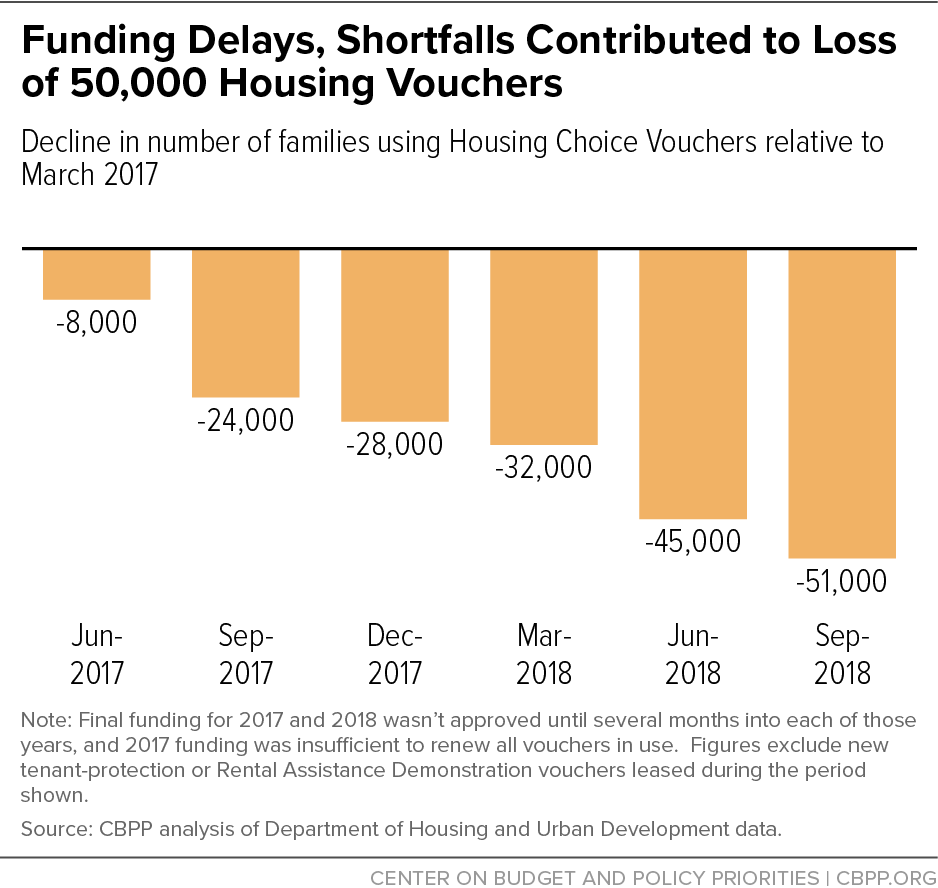Funding Bill and Carryover Funding Should Enable Agencies to Issue More Housing Vouchers in 2019
End Notes
[1] Alison Bell, “HUD Funding Bill Will Launch Housing Voucher Mobility Demonstration,” February 15, 2019, https://www.cbpp.org/blog/hud-funding-bill-will-launch-housing-voucher-mobility-demonstration.
[2] These figures are gross budget authority and do not reflect adjustments for receipts associated with HUD’s mortgage insurance programs in 2018 and 2019. (The bill text is available here: https://www.congress.gov/116/bills/hjres31/BILLS-116hjres31enr.pdf.) The austere spending limits established under the Budget Control Act of 2011 (BCA) have forced cuts, even though Congress deserves credit for prioritizing HUD’s rental assistance programs under the caps. For more on the BCA’s impact, see “Policy Basics: Non-Defense Discretionary Programs,” Center on Budget and Policy Priorities, updated November 14, 2018, https://www.cbpp.org/research/federal-budget/policy-basics-non-defense-discretionary-programs.
[3] For an overview of the bill’s HUD funding provisions, see Alison Bell, “2019 Bill Largely Sustains 2018 HUD Funding Gains,” February 15, 2019, https://www.cbpp.org/blog/2019-bill-largely-sustains-2018-hud-funding-gains.
[4] The bill specifies that renewal funding eligibility for most agencies (other than the 39 agencies participating in the Moving to Work demonstration) in 2019 will be based on their voucher usage and costs in 2018, adjusted for inflation and other factors. HUD has not yet released its renewal inflation factors for 2019, but they will likely average between 3 and 4 percent (they may be higher or lower in particular communities). We estimate that the 2019 renewal appropriation will cover about 99 percent of agencies’ renewal funding eligibility under the formula. HUD will be able to increase agencies’ renewal allocations to 100 percent (or nearly 100 percent) of their eligibility by implementing a “reserve offset.” The 2019 funding bill authorizes HUD to reduce renewal funding allocations for agencies with “excess” reserve balances — in effect, to compel them to use part of their reserves for voucher renewals — in order to free up funds that HUD can use to raise allocations at other agencies up to their full eligibility level. See below for more discussion of agencies’ reserve balances.
[5] Specifically, the bill authorizes HUD to adjust renewal allocations for agencies that (1) experienced increased costs due to “unforeseen circumstances” or portability, (2) have project-based voucher commitments for vouchers that are not yet leased, (3) have increased costs associated with vouchers under the HUD-Veterans Affairs Supportive Housing (VASH) program, or (4) are at risk of having to terminate vouchers due to a funding shortfall.
[6] “Three Out of Four Low-Income At-Risk Renters Do Not Receive Federal Rental Assistance,” Center on Budget and Policy Priorities, https://www.cbpp.org/three-out-of-four-low-income-at-risk-renters-do-not-receive-federal-rental-assistance.
[7] This is because agencies’ renewal and administrative funding eligibility are determined in part by the number of households they assist.
[8] Overall, the total number of households using housing vouchers fell by 18,000 from March 2017 to September 2018. But approximately 20,000 new Rental Assistance Demonstration (RAD) vouchers and 14,000 new tenant protection vouchers were funded separately and leased during this period. These vouchers appear as additional “vouchers leased” in HUD’s Voucher Management System data, but they do not represent net new units of assistance because they are issued to preserve or replace public or other assisted housing. Subtracting out these additions, HUD data show a steeper loss of more than 50,000 housing vouchers as of September 2018.
[9] Douglas Rice, “Housing Vouchers Helping as Many as Funding Allows, Despite Challenges in Some Communities,” Center on Budget and Policy Priorities, forthcoming.
[10] In estimating excess reserves, we followed the methodology that HUD used in implementing a small reserve offset in 2018. Specifically, HUD deemed to be “excess” any reserve balance that exceeded 4, 6, or 12 percent of an agency’s annual funding, depending on whether the agency is large, medium, or small, respectively. In calculating the amount of excess reserves, we also made adjustments for a potential modest reserve offset in 2019, and other factors. The estimates exclude the 39 agencies participating in the Moving to Work (MTW) demonstration; while many have high reserve balances and could assist additional households, they are authorized under MTW to use these funds for purposes other than issuing vouchers.
[11] For updated data on each agency’s voucher funds utilization, see “Housing Choice Voucher Utilization Data,” https://www.cbpp.org/research/national-and-state-housing-data-fact-sheets#table1. For further explanation of agencies’ incentives to improve voucher utilization, as well as an explanation of how to use the data above, see Douglas Rice, “Housing Vouchers Helping as Many as Funding Allows, Despite Challenges in Some Communities,” Center on Budget and Policy Priorities, forthcoming.
[12] Will Fischer, “Research Shows Housing Vouchers Reduce Hardship and Provide Platform for Long-Term Gains Among Children,” Center on Budget and Policy Priorities, October 7, 2015, https://www.cbpp.org/research/housing/research-shows-housing-vouchers-reduce-hardship-and-provide-platform-for-long-term.

